How to Capacity Constrain Vendor Locations in SAP SNP
Executive Summary
- The requirements for vendor capacity modeling have been driven in part by contract manufacturing, where the outsourced plant is not a typical supplier but rather a slave plant.
- Often the question arises as to whether there is value to using a vendor planning book.
- There are several approaches to constrain based planning at vendor locations.
- There is also the issue of modeling the vendor in APO versus ERP.
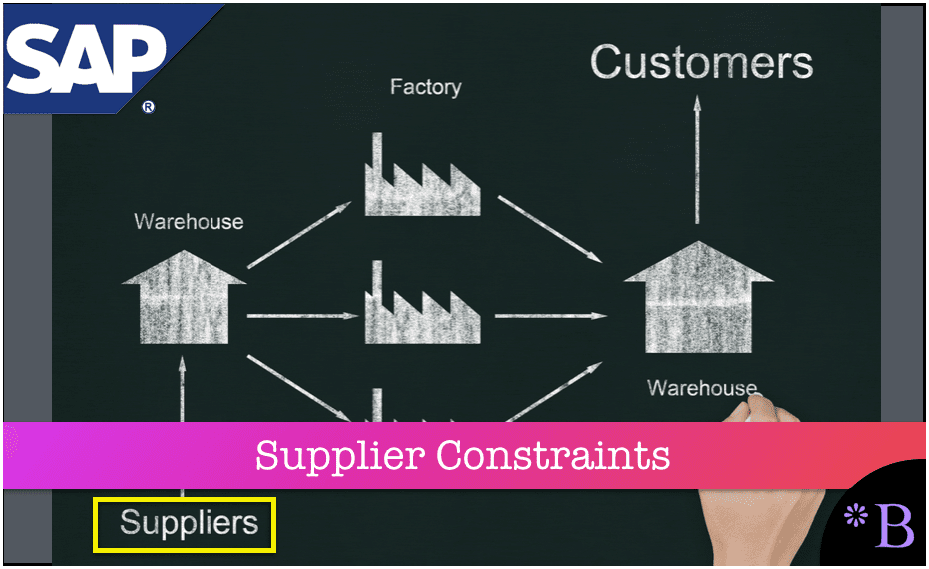
Introduction to Supplier Constraints
This article will address one of the most complex and problematic types of modeling in supply planning, which is capacity constraints for the supplier of a company that has implemented a planning system like SNP. For instance, of all the vendors, only a few are set up to allow multi-company access to their applications in any serious way. One example is PlanetTogether, in the production planning and scheduling space. However, the best that I have seen regarding naturally building collaboration into their product is Arena Solutions.
Our References for This Article
If you want to see our references for this article and other related Brightwork articles, see this link.
Notice of Lack of Financial Bias: We have no financial ties to SAP or any other entity mentioned in this article.
Capacity Constraints at Suppliers
Capacity constraining at suppliers is a common request at some companies. As companies outsource more and more of their production, and with the rise of contract manufacturing where all of the production is outsourced to a third-party, it becomes of even greater interest for OEMs to model and constrains their supplier’s capacity.
One can constrain internal locations, but to determine feasibility, it is necessary to constrain suppliers. There are several challenges to performing supplier capacity constraining. One is the business challenge of getting suppliers to provide updated capacity information. Capacity constraining suppliers can be both passive and active. Passive constraining is the most basic.
In this scenario, the capacity constraints are set on the resources at the supplier/vendor (how this is done will be described further on in this chapter). If the supplier/vendor is planned with either the cost optimizer or capable of matching (CTM), its planned orders will be created in a capacity-constrained way, and the planner will never have to go into the product location combination and perform capacity leveling. This requires that the supplier/vendor provide updated capacity information to its customer – the company running the SAP APO instance.
Modeling a Slave Plant
The second type of constraining is active constraining. This scenario is more appropriate when the company uses contract manufacturing, or the plant is mostly a “slave plant” to the company running the SAP APO instance.
The Rise of Contract Manufacturing
Over the past several decades, manufacturing has become intensively outsourced, and production is seen less and less like a core competency. Contract manufacturing can range from little oversight on the part of the customer company to a great deal of oversight. There is such a simple relationship that can be assumed.
Some contract manufacturing companies are larger than the companies that buy from them and tend to do more planning and control more. In that situation, a passive form of planning would fit the business requirement. However, there are also cases where the customer company wants to highly control the slave or contract manufacturing plant to perform production scheduling. This can be accomplished quite effectively by SAP APO.
Detailed Scheduling by the Customer Company
When the customer company wants to perform detailed scheduling of the slave plant, they would implement PP/DS, other production planning and scheduling tools, and primarily provide the run sequence to the slave plant. The slave plant can be given access to and check the PP/DS planning board and merely make it to its schedule, which the customer company determines. However, that is rarer. The most common scenario is for the customer company to perform either active or passive supply planning and initial production planning and allow the slave plant to perform the production schedule. Purchase requisitions will be created between the internal location and the vendor location (in SAP APO), and these purchase requisitions will initiate planned orders at the vendor location.
The easiest way to understand this, for people with some SNP exposure, is to merely think of the relationship almost the same way as if the requisition (which would be a stock transport requisition) was being sent between two internal locations. Everything, from where the requisition appears (in the Distribution Receipt key figure in the planning book at the internal location and the Distribution Demand key figure in the planning location at the vendor location), is the same.
Is There Value to Using a Vendor Planning Book?
I was asked if there is even any value to going into the vendor planning book product locations if planned with a finite method like CTM or the optimizer. My response is that there can be value because while the requisitions or planned orders would not necessarily be altered in the vendor product locations, the planning book can still serve as a valuable reporting tool. For instance, one could select vendors’ aggregation and quickly see the planned orders and purchase requisitions per period. Creating a selection profile in the planning book for all product and vendor location combinations would enable this. Of course, any subset of product or vendor location could also be viewed similarly.
Technically Setting up the Solution in SNP
The technical setup for this solution starts at the resource. When internal locations are planned in APO, the BOM, routing, and work center/resource is set up in ERP and then brought into APO through the CIF to create either a PPM or a PDS (master data objects that combined the BOM, routing, and work center/routing). ERP does not allow external locations to contain BOMs, routing, and work centers/resources. However, APO does allow this. Secondly, between the PPM and PDS, only the PPM can be created within APO.
Therefore, when one needs to set up resources in an external location, the PPM can be created in APO without representing the resource at the vendor location in ERP. Purchase requisitions are converted to purchase orders between the internal and vendor locations, and capacity management at the vendor location becomes an entirely APO-related affair. ERP essentially never sees this setup, and in fact, does not need to.
The Delivery Mechanisms of Production Resource Information
Some companies create delivery mechanisms for supplier and contract manufacturer information. One of the more popular is E2Open. SAP offers a product called SAP APO SNC, which, while lightly installed, also proposes to deliver supplier information to the planning system. However, regardless of the delivery mechanism of resource data, the resources must be set up in SAP APO. The questions become where to set these resources up. This leads to the next topic, which is related to location types.
The Limitation of Location Types and the Way Around Them
Location types have specific activities they can perform in SAP ERP. However, location types in APO are much more flexible. As this article describes, SAP APO takes some things that are not locations in SAP ERP and converts them into APO locations.
SAP has rules regarding what activities can be performed in each location. For instance, if a location is modeled as a supplied in APO, and the requirements are to model its capacity, it must have PPMs (not PDSs as they cannot go back to ERP, as SAP ERP will not accept BOMs, routings, or work centers in a vendor location)
See the MRP setting below:
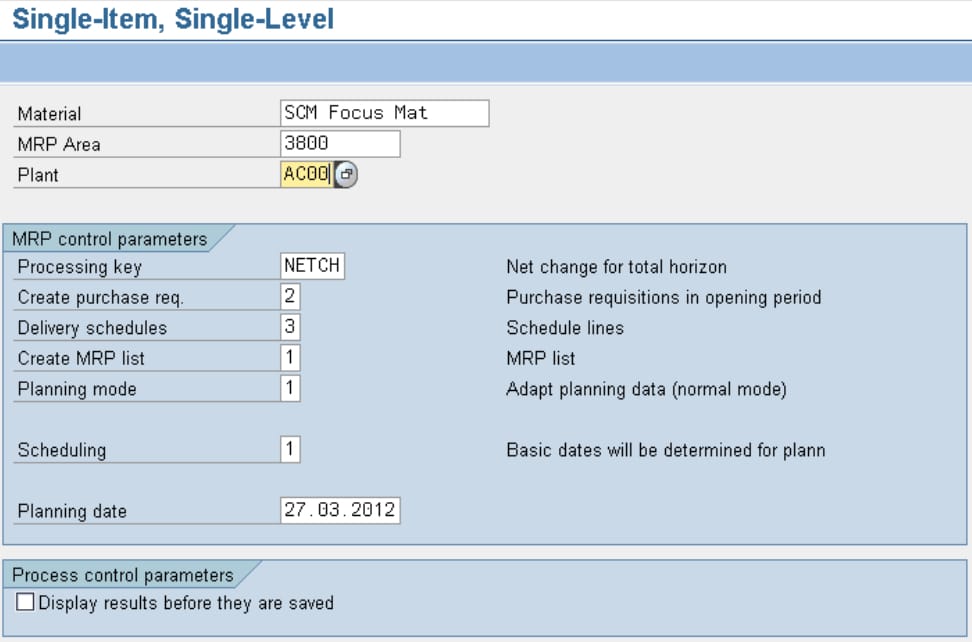
Constraining Transportation Lane?
How about setting up the constraints through a different configuration mechanism? I was not aware of one until I was working at one client that a previous consultant told, a supplier could be constrained by constraining the transportation lane. I reviewed the transportation lane and did not find where the transportation lane is capacity constrained.
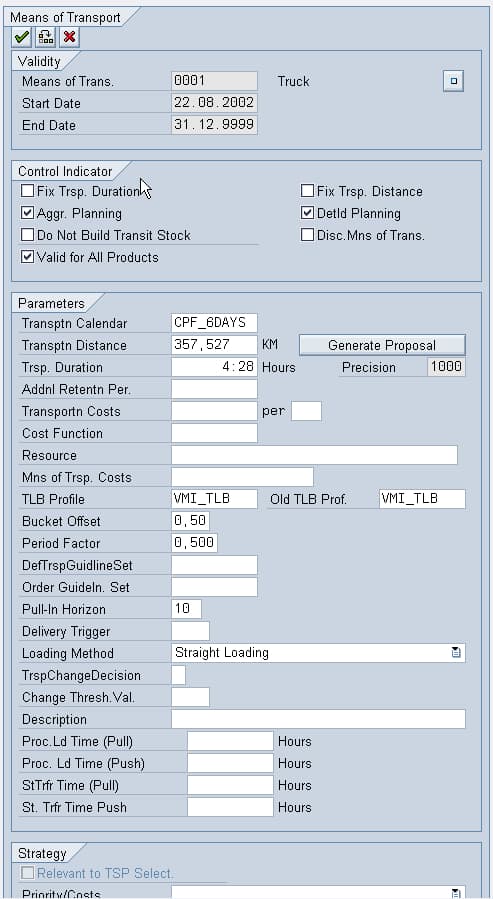
A lot size can be set on the transportation lane. However, that only controls how large a load will be that is placed on the truck. This does not make a lot of sense to me as the truck should determine the maximum amount of material placed on a truck, and these settings are in the transportation load builder profile, which is described in these articles.
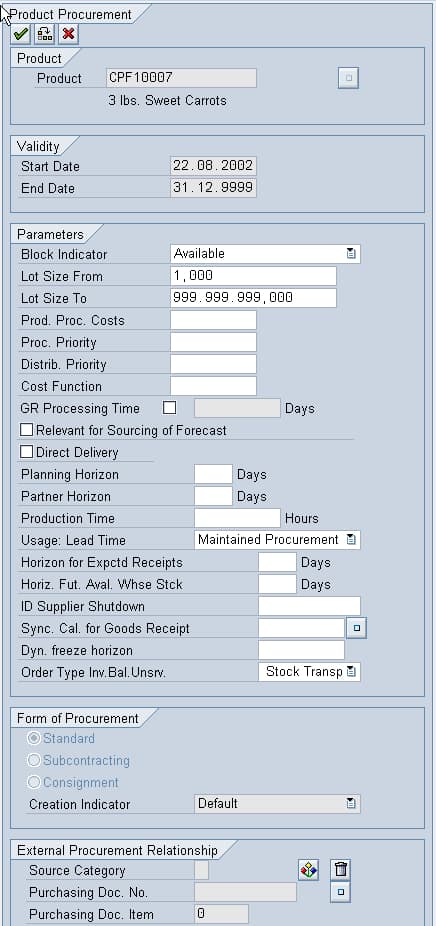 I also did not find anything in my internet searches that described constraining the transportation lane. Of course, transportation resources can be constrained on a lane, but this is not related to production but to how many available transportation resources. It also only constrains the total amount of material that can flow between facilities (that is, if more than one item were placed on the transportation resource, it would not control the quantity of one versus the amount of another. However, there is a transaction /SAPAPO/RSPDRP1, and in this option, there is a transportation lane capacity.
I also did not find anything in my internet searches that described constraining the transportation lane. Of course, transportation resources can be constrained on a lane, but this is not related to production but to how many available transportation resources. It also only constrains the total amount of material that can flow between facilities (that is, if more than one item were placed on the transportation resource, it would not control the quantity of one versus the amount of another. However, there is a transaction /SAPAPO/RSPDRP1, and in this option, there is a transportation lane capacity.
The Transportation Lane and the SNP Heuristic
According to the SAP documentation, this works with the SNP heuristic to consider the vendor capacity specified in the Key Figure: Maximum Capacity Field for a scheduling agreement’s transportation lanes. However, others have had problems finding the field “Maximum Capacity.”
Again this assumes that setting an aggregate capacity at a vendor is a requirement. That is not the requirement of most companies that want to model capacity at a supplier. Constraining the lane makes no sense to me and is not modeling the supplier capacity. I am unclear as to why this functionality was created in the first place.
Vendor Location Routes
The vendor locations can have the routes between them and the internal customer company locations automatically created as transportation lanes in APO. These transportation lanes are made from the purchasing info record in ERP. Not all vendor locations need to be connected to internal locations with a transportation lane, but it does have some advantages concerning consistency. However, transportation lanes do require more maintenance than the second option.
APO can use either the transportation lane or the Planned Delivery Time field, which is on the Procurement Tab of the product location master, to calculate the transportation lead-time.
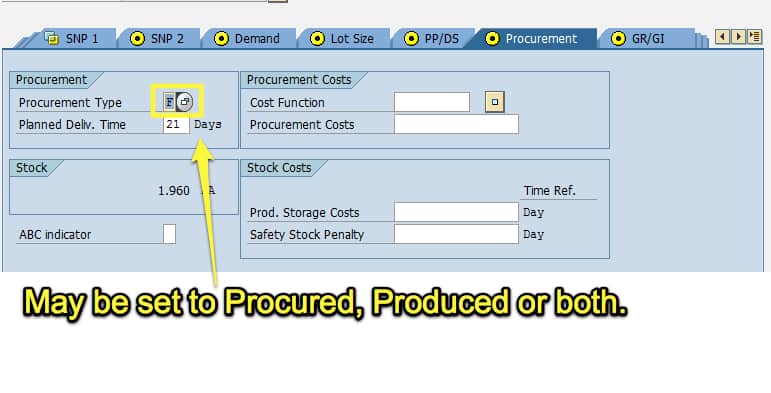 Conclusion
Conclusion
SNPs can be set up to constrain supplier production resources through the design explained in this article. There are several ways to manage the capacity of the vendor location. The vendor can be unconstrained, and in this case, the overall supply plan cannot be considered to be “feasible” if there are, in fact, constraints at the supplier. (Some suppliers are known to be capacity constrained, while others are not). This is the most straightforward approach, as it does not even require any resources to be set up at the vendor location. In this case, the supplier is merely an unlimited bucket where supply can be sourced.
The second approach is to model the vendor location passively. This means that the vendor locations are modeled with a constraint-based method (CTM or the optimizer). The location is not actively or manually changed regarding the movement of planned orders. The third approach is to actively manage the vendor, which means changes are made manually. The customer company is, in effect, performing initial supply planning and initial production planning for the vendor location. The most extreme example of vendor location management is when the vendor is a production scheduled and the customer company’s supply and production. In this scenario, the vendor is essentially acting as a slave plant to the customer company and simply executing production.
The technical configuration of modeling vendor capacities is to set up a PPM in the vendor, created in APO and not represented in SAP ERP. All maintenance of resources and the PPM is then performed inside of APO. Internal production locations can still use PDSs or PPMs that interoperate with SAP ERP, but the PPMs at the vendor locations do not. There is nothing inconsistent with using PPMs and PDSs in implementation, although it means more overhead and training for resources to become proficient in managing and troubleshooting both.